Comfort, Energy Efficiency and Adoption of Personal Cooling Systems in Warm Environments: A Field Experimental Study
Abstract
:1. Introduction
- (1)
- To compare the comfort performances of several personal cooling systems, i.e., radiant cooling desk, desk fans and their combinations, in warm environments;
- (2)
- To propose an improved CEP index which is possible to compare various personal cooling systems (not only those in this study);
- (3)
- To understand how people feel about personal cooling and how they decide to adopt it.
2. Methods
2.1. Consent
2.2. Location and Climate
2.3. Experimental Room and Personal Cooling Systems
2.4. Experimental Procedure
2.5. Experimental Conditions
2.6. Participants
2.7. Instruments for Measurements
2.8. Questionnaires
2.9. Cooling Capacity and the Improved CEP Index
- (1)
- Coefficient of Performance (COP) was added in. Since water-cooling systems directly use cool water while fans consume electricity, COP is taken in for obtaining the equivalent electrical power. For water-cooling systems, COP can be determined by the water temperature, while for other cooling devices which used electricity (like fans), the COP value can be regarded as 1.0. As a result, it is possible to compare energy efficiencies of different personal cooling systems. As summarized in [33], when supply water temperature is higher than 16 °C, the COP of chiller can be higher than 8.5. Since the water temperature in this study was higher than 16 °C, the COP for radiant cooling desk was regarded as 8.5. The improved CEP index could be expressed as below:where Q’ is the average cooling energy (W). For water-cooling systems, it is the value of average cooling capacity. For fans, it is the value of average electrical power.When multiple personal cooling systems are used simultaneously, the CEP value is equal to the sum of those of all systems. Subsequently, the CEP value can be calculated as below:where n is the serial number of personal cooling systems, N is the total number of personal cooling systems used simultaneously under one condition.
- (2)
- Different comfort levels were defined. Corresponding to 80% and 90% acceptable range, thermal sensation votes are within the range of −0.85 to +0.85 and −0.5 to +0.5, respectively [16]. Thus, according to the results of thermal sensation votes corresponding to 80% and 90% acceptable range, respectively, CEP were calculated and expressed in two ways: CEP80% and CEP90%. Further, similar with [25], the average value of CEP and the lowest CP (meaning the largest ability to extend the acceptable temperature range) can be used together as a simplified way to present the performances of personal cooling systems. Thus the simplified CEP index is expressed as or ( and are average values of CEP values when thermal sensation votes are within 80% and 90% acceptable ranges, respectively).
- (3)
- A common baseline (without personal cooling systems) was defined for comparing different personal cooling systems. Thus, CP values of different personal cooling systems could be comparable. The common baseline is set at the temperature of 26 °C. Please refer to Section 3.2 for details.
2.10. The Feedback
2.11. Statistical Analysis
3. Results
3.1. Comfort Performances of Personal Cooling Systems
3.1.1. Thermal Sensation and Comfort
3.1.2. Thermal Acceptability and Preference
3.1.3. Air Movement Sensation and Preference
3.1.4. Other Discomfort Symptoms
3.2. Energy Efficiencies and CEP Index
3.3. Comments on Personal Cooling Systems and the Adoption Model
4. Discussion
4.1. Comparisons among Different Personal Cooling Systems
4.2. Adoption of Personal Cooling Systems
4.3. Limitations and Suggestions
5. Conclusions
- (1)
- Personal cooling systems reduced the warmth sensation and improved the comfort of participants in warm environments. Specially, the combination of radiant cooling desk and desk fan well extended the acceptable temperature range to 32 °C.
- (2)
- The radiant cooling desk lowered the draft risk and the desk fan reduced participants’ complaints about the humid environment and the indoor air. Thus allowing personal control over their combination maybe a better choice to further improve subjective comfort.
- (3)
- The improved CEP index was proposed and it provided a practical way to compare different types of personal cooling systems in terms of comfort and energy efficiency at the same time.
- (4)
- According to the results of our improved CEP index, desk fans were more energy-efficient and suitable for participants in the environment where the air temperature was not higher than 30 °C, while the combination of radiant cooling desk and desk fan consumed more energy, but was superior to desk fans in terms of extending the comfortable temperature range.
- (5)
- Under the free mode, most of participants were willing to adopt personal cooling systems and the effectiveness was the main factor influencing the willingness, while under the charge mode, most participants did not want to adopt personal cooling due to its perceived cost and the availability of conventional air conditioners.
Acknowledgments
Author Contributions
Conflicts of Interest
References
- Ghosh, D.; Wang, M.; Wolfe, E.; Chen, K.; Kaushik, S.; Han, T. Energy efficient HVAC system with spot cooling in an automobile-design and CFD analysis. SAE Int. J. Passeng. Cars-Mech. Syst. 2012, 5, 885–903. [Google Scholar] [CrossRef]
- Oh, M.S.; Ahn, J.H.; Kim, D.W.; Jang, D.S.; Kim, Y. Thermal comfort and energy saving in a vehicle compartment using a localized air-conditioning system. Appl. Energy 2014, 133, 14–21. [Google Scholar] [CrossRef]
- Zhang, H.; Arens, E.; Taub, M.; Dickerhoff, D.; Bauman, F.; Fountain, M.; Pasut, W.; Fannon, D.; Zhai, Y.C.; Pigman, M. Using footwarmers in offices for thermal comfort and energy savings. Energy Build. 2015, 104, 233–243. [Google Scholar] [CrossRef]
- Zhang, H.; Arens, E.; Zhai, Y. A review of the corrective power of personal comfort systems in non-neutral ambient environments. Build. Environ. 2015, 91, 15–41. [Google Scholar] [CrossRef]
- Atthajariyakul, S.; Lertsatittanakorn, C. Small fan assisted air conditioner for thermal comfort and energy saving in Thailand. Energy Convers. Manag. 2008, 49, 2499–2504. [Google Scholar] [CrossRef]
- Yang, L.; Yan, H.; Lam, J.C. Thermal comfort and building energy consumption implications—A review. Appl. Energy 2014, 115, 164–173. [Google Scholar] [CrossRef]
- Hoyt, T.; Arens, E.; Zhang, H. Extending air temperature setpoints: Simulated energy savings and design considerations for new and retrofit buildings. Build. Environ. 2015, 88, 89–96. [Google Scholar] [CrossRef]
- Huang, K.D.; Tzeng, S.-C.; Jeng, T.-M.; Chiang, W.-D. Air-conditioning system of an intelligent vehicle-cabin. Appl. Energy 2006, 83, 545–557. [Google Scholar] [CrossRef]
- Cui, W.; Wu, T.; Ouyang, Q.; Zhu, Y. Passenger thermal comfort and behavior: A field investigation in commercial aircraft cabins. Indoor Air 2017, 27, 94–103. [Google Scholar] [CrossRef] [PubMed]
- Chen, Y.; Raphael, B.; Sekhar, S.C. Experimental and simulated energy performance of a personalized ventilation system with individual airflow control in a hot and humid climate. Build. Environ. 2016, 96, 283–292. [Google Scholar] [CrossRef]
- Chakroun, W.; Ghaddar, N.; Ghali, K. Chilled ceiling and displacement ventilation aided with personalized evaporative cooler. Energy Build. 2011, 43, 3250–3257. [Google Scholar] [CrossRef]
- Yang, B.; Sekhar, C.; Melikov, A.K. Ceiling mounted personalized ventilation system in hot and humid climate—An energy analysis. Energy Build. 2010, 42, 2304–2308. [Google Scholar] [CrossRef]
- Schiavon, S.; Melikov, A.K. Introduction of a cooling-fan efficiency index. HVAC R Res. 2009, 15, 1121–1144. [Google Scholar] [CrossRef]
- Watanabe, S.; Shimomura, T.; Miyazaki, H. Thermal evaluation of a chair with fans as an individually controlled system. Build. Environ. 2009, 44, 1392–1398. [Google Scholar] [CrossRef]
- Boerstra, A.C.; Kulve, M.T.; Toftum, J.; Loomans, M.G.L.C.; Olesen, B.W.; Hensen, J.L.M. Comfort and performance impact of personal control over thermal environment in summer: Results from a laboratory study. Build. Environ. 2015, 87, 315–326. [Google Scholar] [CrossRef]
- American Society of Heating, Refrigerating and Air-Conditioning Engineering. Standard 55-2010: Thermal Environmental Conditions for Human Occupancy; American Society of Heating, Refrigerating and Air-Conditioning Engineering: Atlanta, GA, USA, 2010. [Google Scholar]
- Dalewski, M.; Melikov, A.K.; Vesely, M. Performance of ductless personalized ventilation in conjunction with displacement ventilation: Physical environment and human response. Build. Environ. 2014, 81, 354–364. [Google Scholar] [CrossRef]
- Pasut, W.; Zhang, H.; Arens, E.; Zhai, Y. Energy-efficient comfort with a heated/cooled chair: Results from human subject tests. Build. Environ. 2015, 84, 10–21. [Google Scholar] [CrossRef]
- He, Y.; Wang, X.; Li, N.; He, M.; He, D.; Wang, K. Cooling ceiling assisted by desk fans for comfort in hot-humid environment. Build. Environ. 2017, 122, 23–34. [Google Scholar] [CrossRef]
- Zhai, Y.; Zhang, H.; Zhang, Y.; Pasut, W.; Arens, E.; Meng, Q. Comfort under personally controlled air movement in warm and humid environments. Build. Environ. 2013, 65, 109–117. [Google Scholar] [CrossRef]
- Zhai, Y.; Zhang, Y.; Zhang, H.; Pasut, W.; Arens, E.; Meng, Q. Human comfort and perceived air quality in warm and humid environments with ceiling fans. Build. Environ. 2015, 90, 178–185. [Google Scholar] [CrossRef]
- Huang, L.; Ouyang, Q.; Zhu, Y.; Jiang, L. A study about the demand for air movement in warm environment. Build. Environ. 2013, 61, 27–33. [Google Scholar] [CrossRef]
- He, Y.; Li, N.; He, M.; He, D. Using radiant cooling desk for maintaining comfort in hot environment. Energy Build. 2017, 145, 144–154. [Google Scholar] [CrossRef]
- Wang, F.; Song, W. An investigation of thermophysiological responses of human while using four personal cooling strategies during heatwaves. J. Therm. Biol. 2017, 70, 37–44. [Google Scholar] [CrossRef] [PubMed]
- He, Y.; Li, N.; Zhou, L.; Wang, K.; Zhang, W. Thermal comfort and energy consumption in cold environment with retrofitted Huotong (warm-barrel). Build. Environ. 2017, 112, 285–295. [Google Scholar] [CrossRef]
- Wang, Z.; Zhang, L.; Zhao, J.; He, Y. Thermal comfort for naturally ventilated residential buildings in Harbin. Energy Build. 2010, 42, 2406–2415. [Google Scholar] [CrossRef]
- He, Y.; Li, N.; Peng, J.; Zhang, W.; Li, Y. Field study on adaptive comfort in air conditioned dormitories of university with hot-humid climate in summer. Energy Build. 2016, 119, 1–12. [Google Scholar] [CrossRef]
- Mustapa, M.S.; Zaki, S.A.; Rijal, H.B.; Hagishima, A.; Ali, M.S.M. Thermal comfort and occupant adaptive behaviour in Japanese university buildings with free running and cooling mode offices during summer. Build. Environ. 2016, 105, 332–342. [Google Scholar] [CrossRef]
- Kim, J.; de Dear, R.; Parkinson, T.; Candido, C. Understanding patterns of adaptive comfort behaviour in the Sydney mixed-mode residential context. Energy Build. 2017, 141, 274–283. [Google Scholar] [CrossRef]
- Zhang, Q.; Yang, H. Typical Meteorological Database Handbook for Buildings; China Building Industry Press: Beijing, China, 2012. [Google Scholar]
- Tyler, H.; Stefano, S.; Alberto, P.; Dustin, M.; Kyle, S. CBE Thermal Comfort Tool. Available online: http://cbe.berkeley.edu/comforttool/ (accessed on 17 October 2017).
- International Organization for Standardization. ISO 7730: Ergonomics of the Thermal Environment–Analytical Determination and Interpretation of Thermal Comfort Using Calculation of the PMV and PPD Indices and Local Thermal Comfort Criteria; International Organization for Standardization: Geneva, Switzerland, 2005. [Google Scholar]
- Hu, R.; Niu, J.L. A review of the application of radiant cooling & heating systems in Mainland China. Energy Build. 2012, 52, 11–19. [Google Scholar]
- He, Y.; Li, N.; Zhang, W.; Zhou, L. Thermal comfort of sellers with a kind of traditional personal heating device (Huotong) in marketplace in winter. Build. Environ. 2016, 106, 219–228. [Google Scholar] [CrossRef]
- Melikov, A.K.; Kaczmarczyk, J. Air movement and perceived air quality. Build. Environ. 2012, 47, 400–409. [Google Scholar] [CrossRef]
- Fang, L.; Clausen, G.; Fanger, P.O. Impact of temperature and humidity on the perception of indoor air quality. Indoor Air 1998, 8, 80–90. [Google Scholar] [CrossRef]
- Zhang, H.; Arens, E.; Kim, D.; Buchberger, E.; Bauman, F.; Huizenga, C. Comfort, perceived air quality, and work performance in a low-power task—Ambient conditioning system. Build. Environ. 2010, 45, 29–39. [Google Scholar] [CrossRef]
- Pasut, W.; Zhang, H.; Arens, E.; Zhai, S.K.; Zhai, Y. Effect of a heated and cooled office chair on thermal comfort. HVAC R Res. 2013, 19, 574–583. [Google Scholar]
- Cui, W.; Cao, G.; Ouyang, Q.; Zhu, Y. Influence of dynamic environment with different airflows on human performance. Build. Environ. 2013, 62, 124–132. [Google Scholar] [CrossRef]
- Day, J.K. Occupant Training in High Performance Buildings: An Assessment of Environmental Satisfaction, Learning, and Behaviors in Buildings; Washington State University: Pullman, WA, USA, 2014. [Google Scholar]
- Delmas, M.A.; Fischlein, M.; Asensio, O.I. Information Strategies and Energy Conservation Behavior: A Meta-Analysis of Experimental Studies from 1975–2012. Available online: http://www.escholarship.org/uc/item/25975163 (accessed on 17 October 2017).
- Chen, C.; Xu, X.; Day, J.K. Thermal comfort or money saving? Exploring intentions to conserve energy among low-income households in the United States. Energy Res. Soc. Sci. 2017, 26, 61–71. [Google Scholar] [CrossRef]
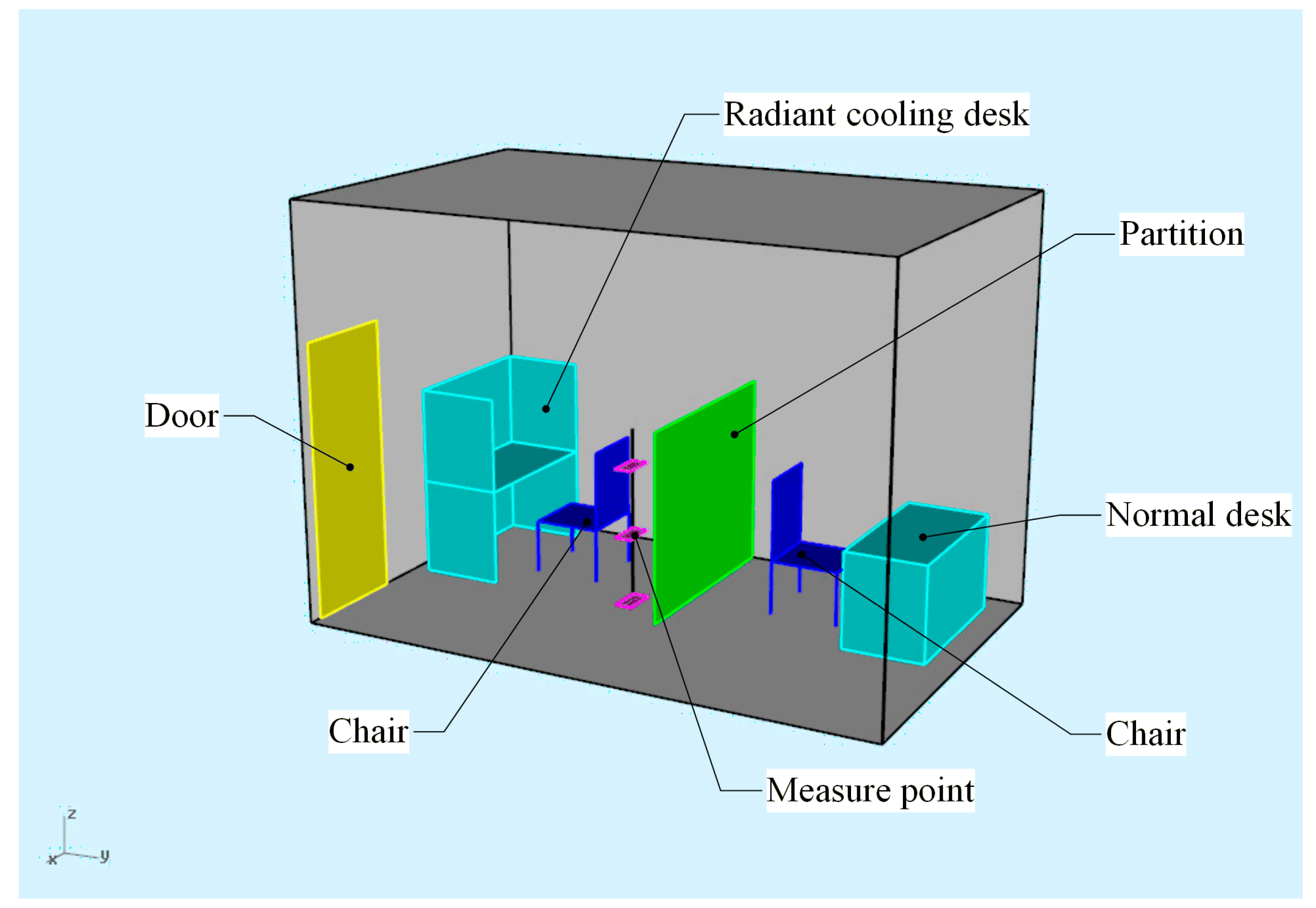
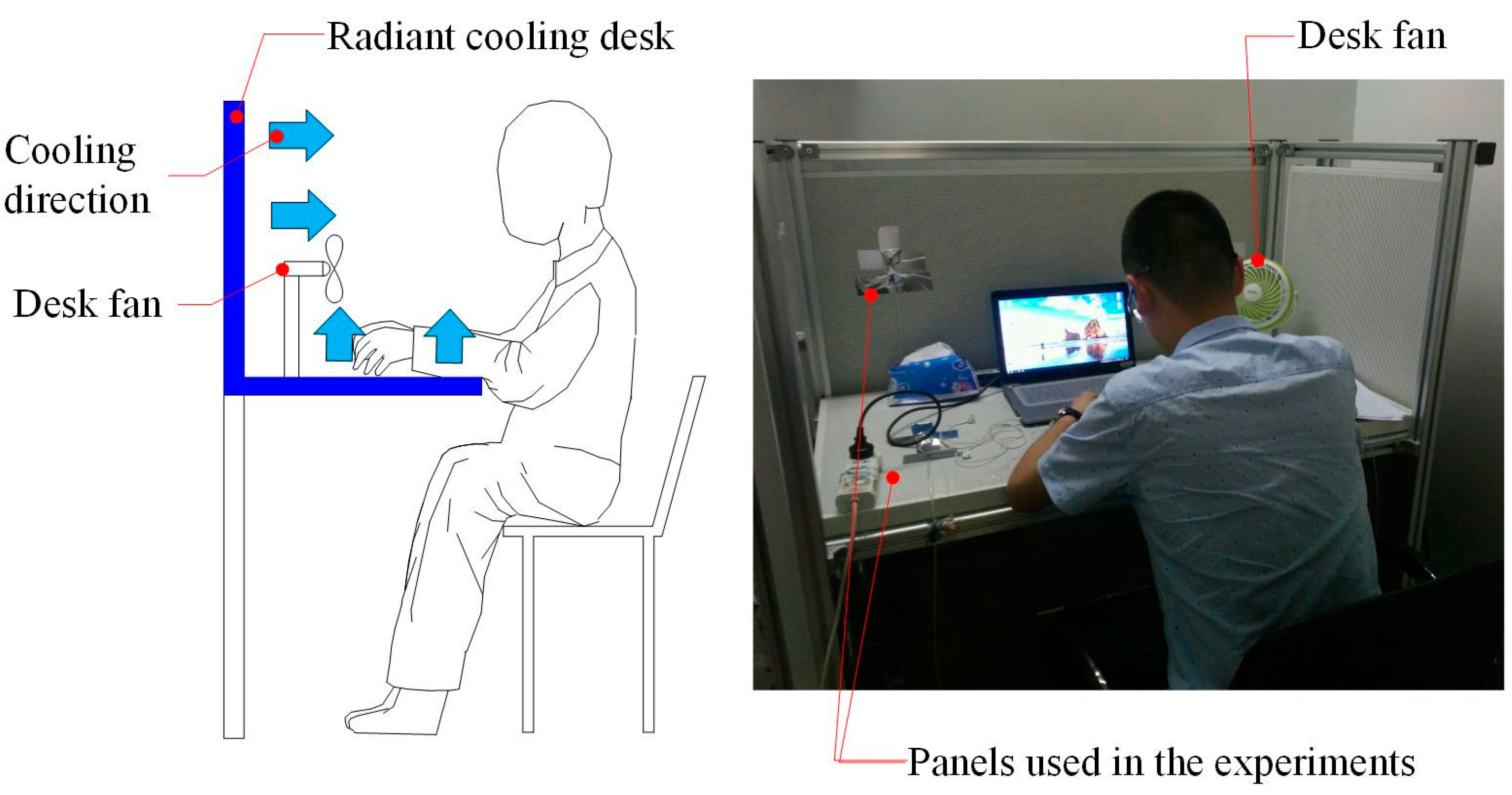
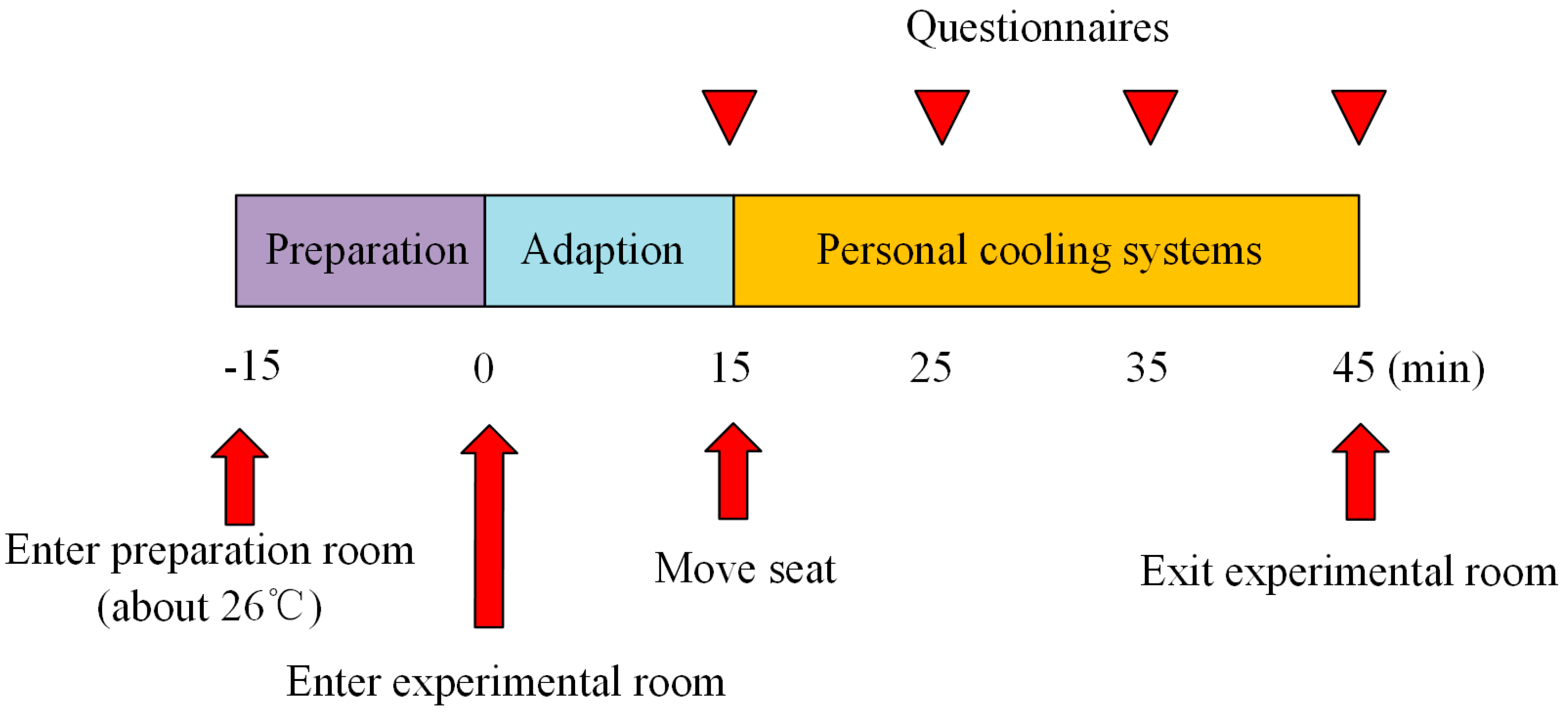
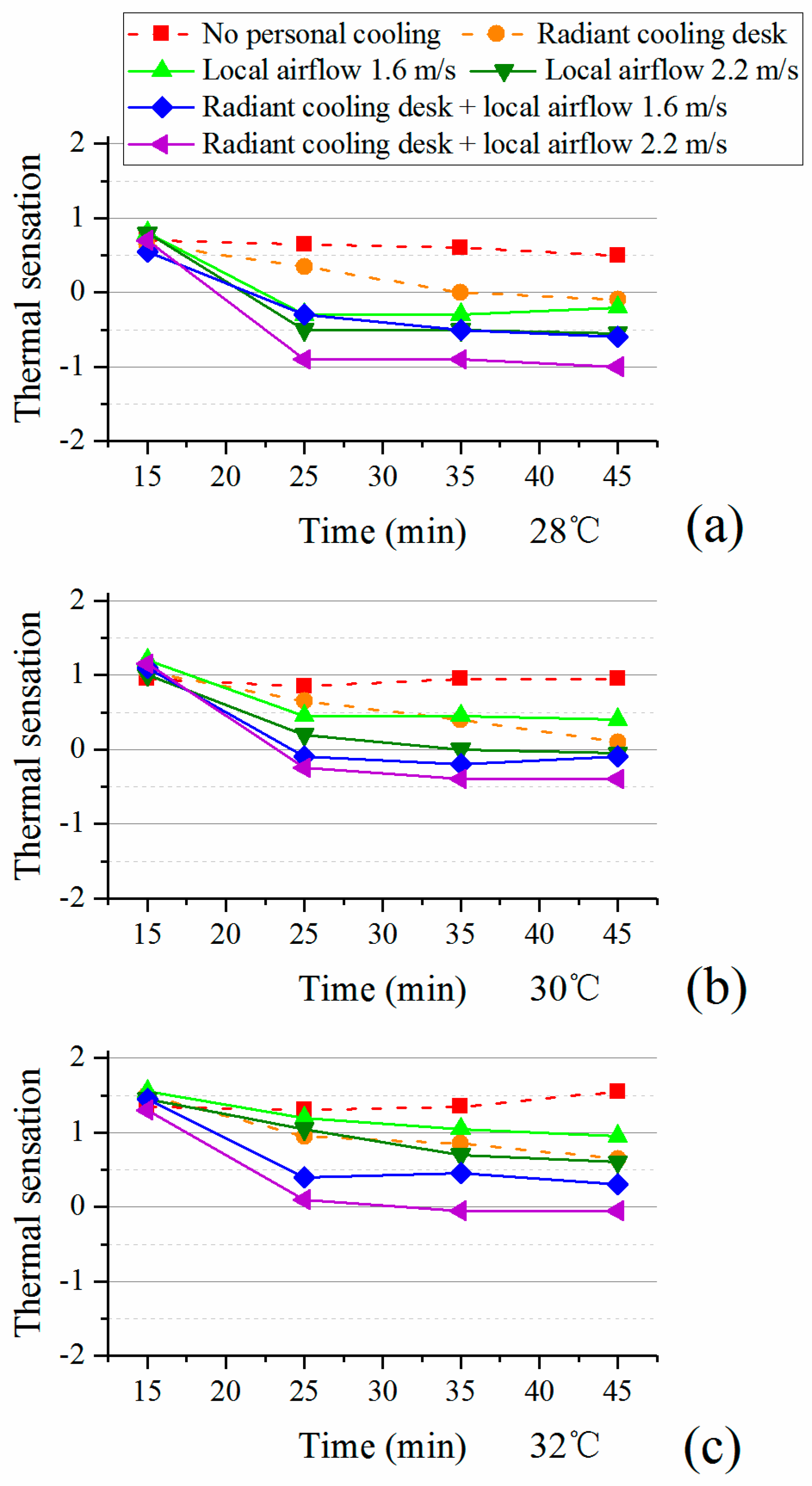
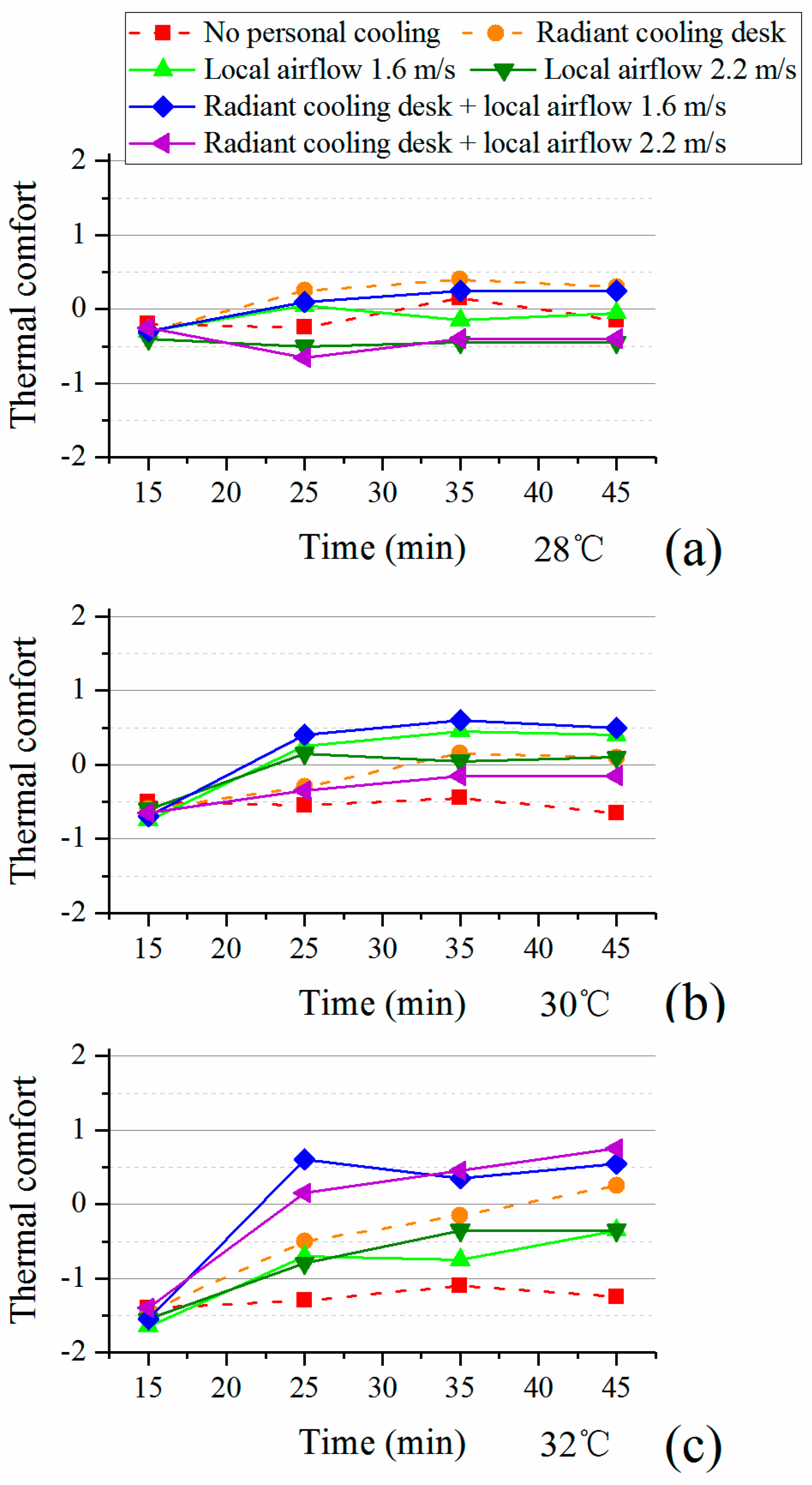
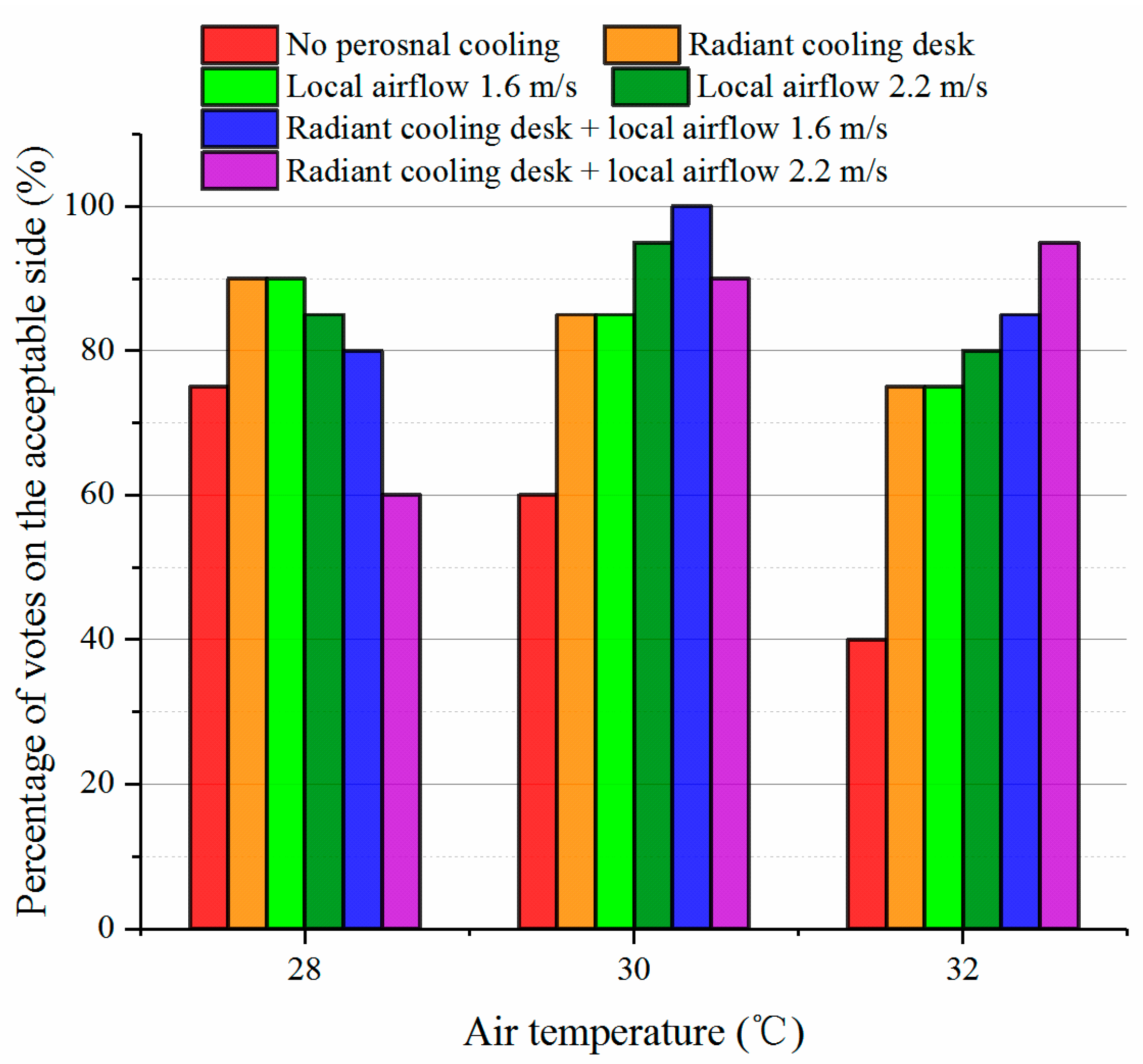


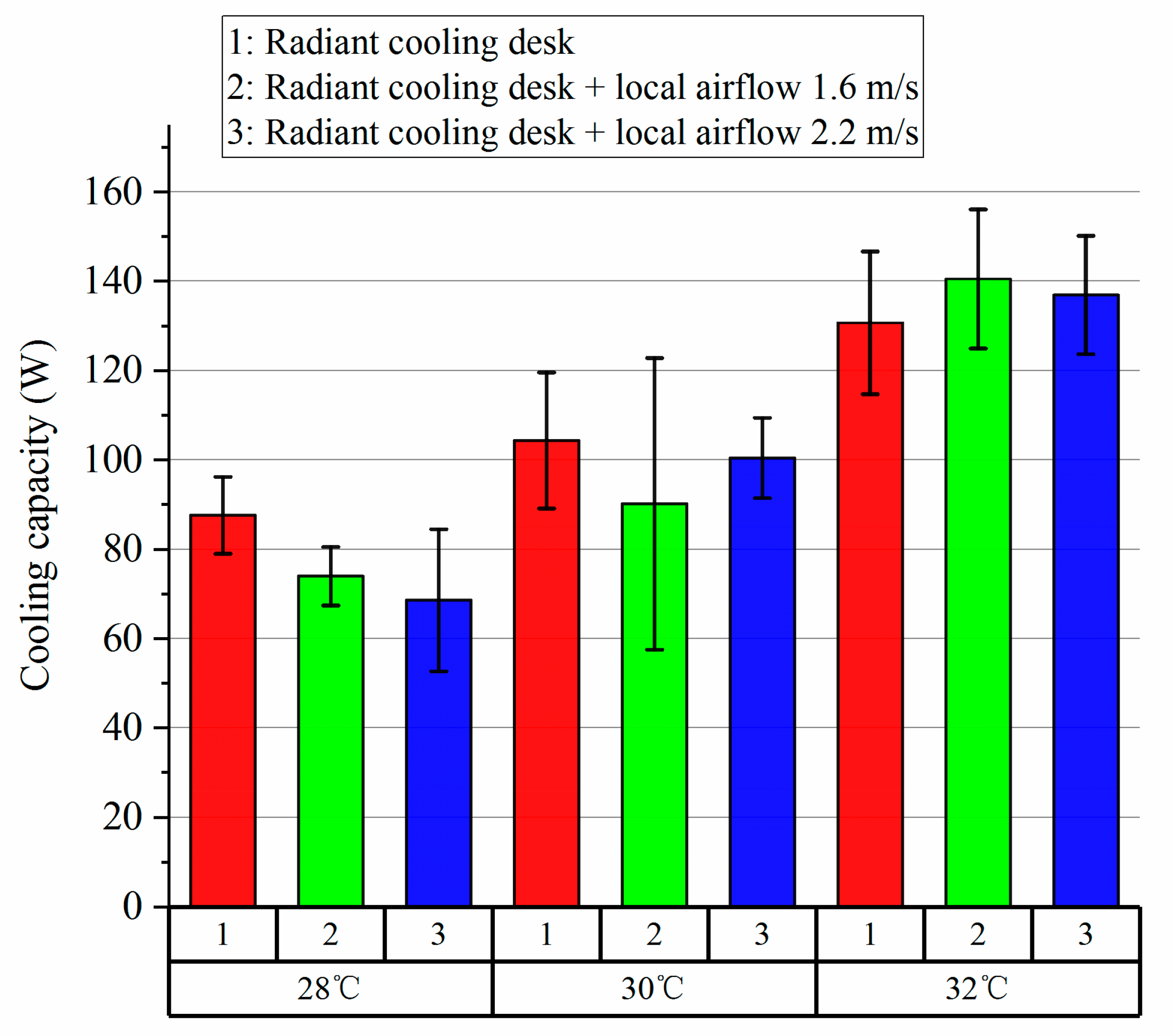
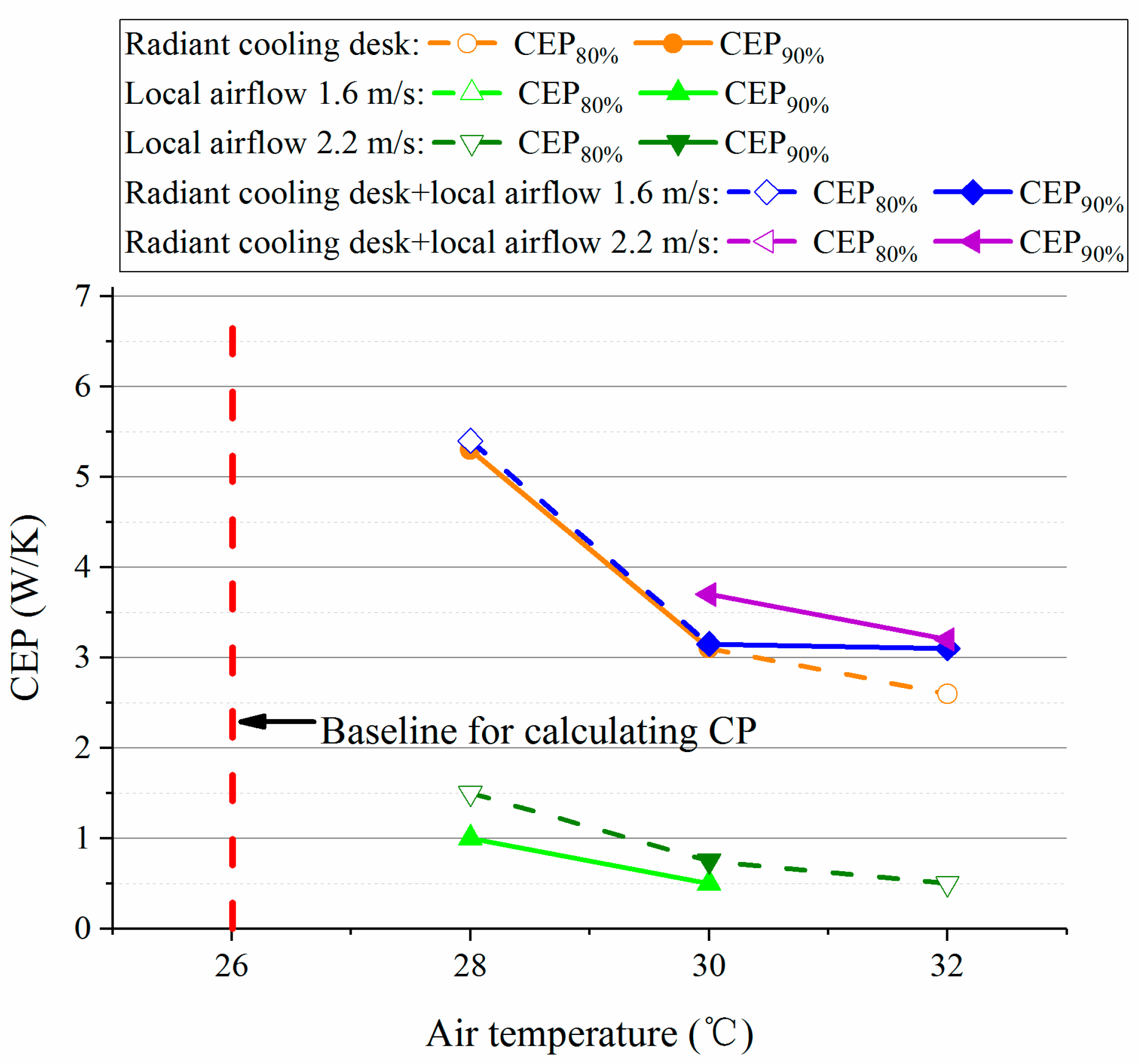
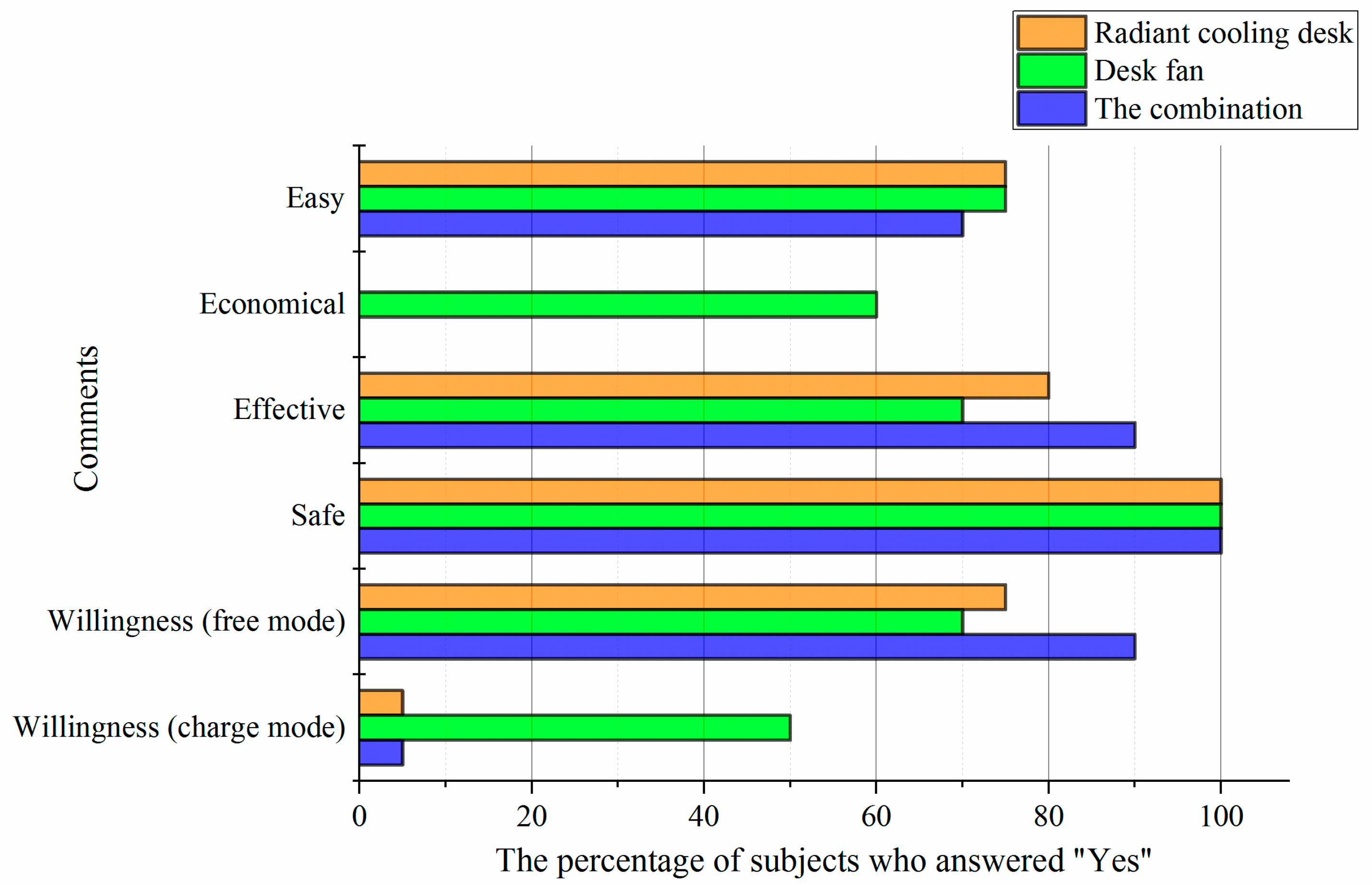
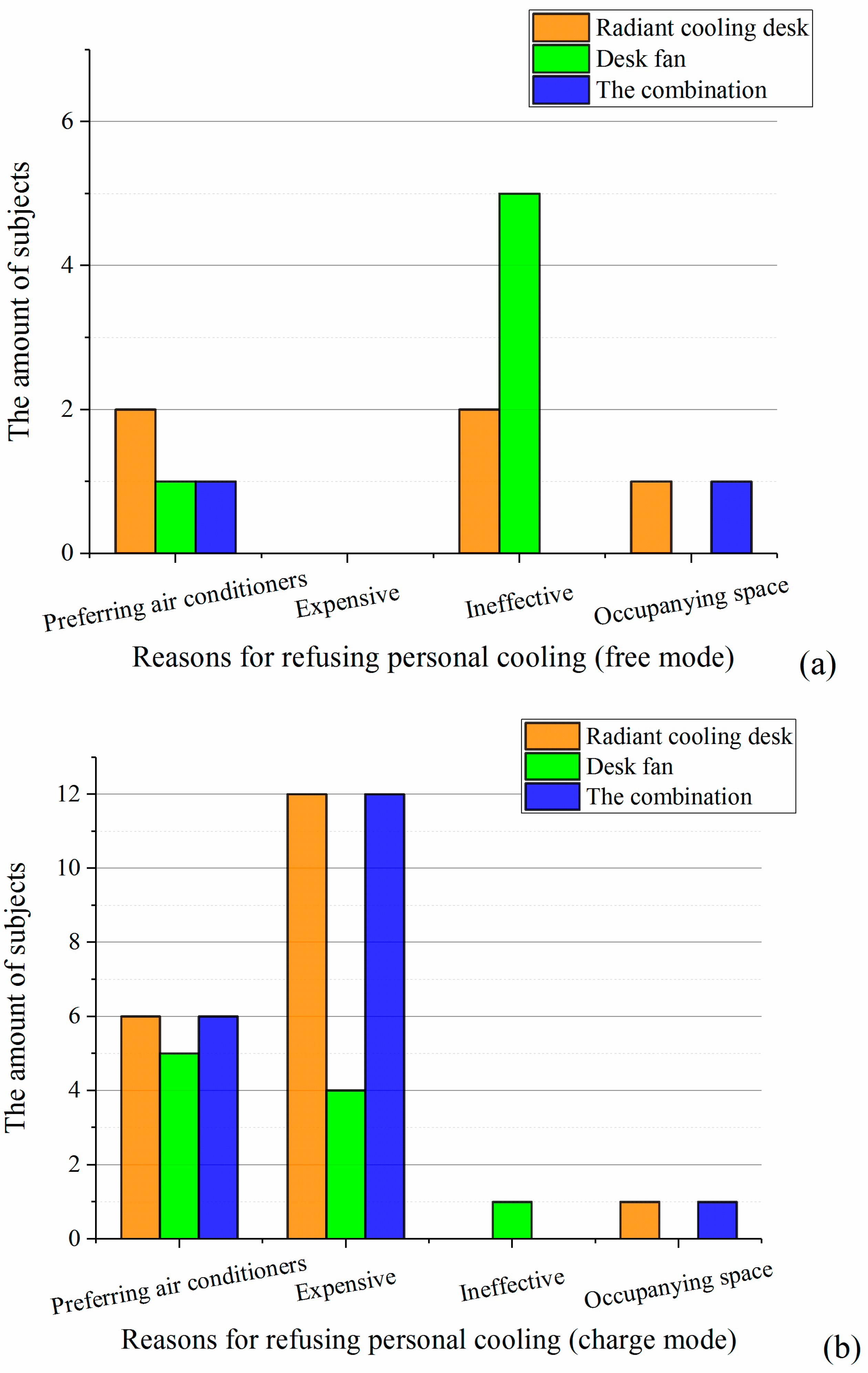
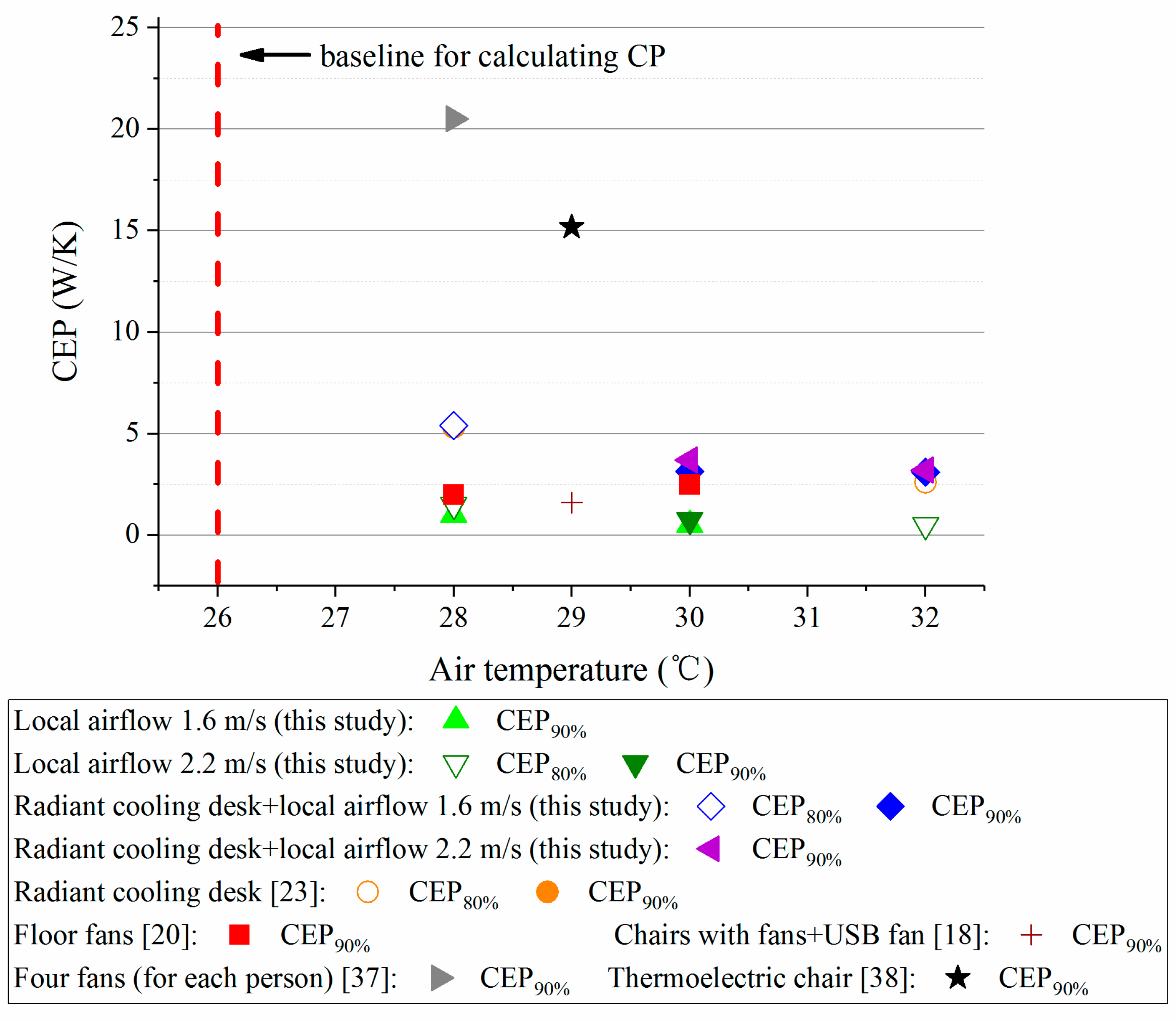
| Physical Parameters 1 | Conditions | |||||
|---|---|---|---|---|---|---|
| 1 | 2 | 3 | 4 | 5 | 6 | |
| Radiant cooling desk | No | No | No | No | No | No |
| Local airflow 2 (m/s) | 1.6 | 2.2 | 1.6 | 2.2 | 1.6 | 2.2 |
| Air temperature 1.1 m (°C) | 28.5 ± 0.5 | 28.7 ± 0.4 | 30.8 ± 0.4 | 30.7 ± 0.4 | 33.0 ± 0.4 | 32.8 ± 0.5 |
| Air temperature 0.6 m (°C) | 27.8 ± 0.5 | 28.1 ± 0.5 | 30.2 ± 0.4 | 29.8 ± 0.5 | 32.3 ± 0.5 | 32.0 ± 0.4 |
| Air temperature 0.1 m (°C) | 27.1 ± 0.3 | 27.2 ± 0.4 | 29.0 ± 0.4 | 28.7 ± 0.5 | 31.6 ± 0.4 | 31.3 ± 0.3 |
| Relative humidity (%) | 57 ± 5 | 60 ± 6 | 62 ± 4 | 59 ± 5 | 59 ± 4 | 63 ± 4 |
| MRT (°C) | 28.0 ± 0.4 | 28.3 ± 0.4 | 30.7 ± 0.3 | 30.2 ± 0.3 | 32.5 ± 0.3 | 32.3 ± 0.4 |
| Air velocity (m/s) | 0.06 ± 0.03 | 0.05 ± 0.04 | 0.09 ± 0.03 | 0.07 ± 0.03 | 0.05 ± 0.04 | 0.06 ± 0.03 |
| Dew point (°C) | - | - | - | - | - | - |
| PMV | 0.83 | 0.97 | 1.80 | 1.65 | 2.57 | 2.52 |
| PPD | 19% | 25% | 67% | 59% | 95% | 94% |
| 7 | 8 | 9 | 10 | 11 | 12 | |
| Radiant cooling desk | Yes | Yes | Yes | Yes | Yes | Yes |
| Local airflow 2 (m/s) | 1.6 | 2.2 | 1.6 | 2.2 | 1.6 | 2.2 |
| Air temperature 1.1 m (°C) | 28.8 ± 0.5 | 28.6 ± 0.5 | 31.0 ± 0.4 | 30.7 ± 0.3 | 32.9 ± 0.4 | 32.6 ± 0.4 |
| Air temperature 0.6 m (°C) | 28.2 ± 0.4 | 27.9 ± 0.5 | 30.3 ± 0.4 | 29.9 ± 0.4 | 32.2 ± 0.3 | 32.0 ± 0.4 |
| Air temperature 0.1 m (°C) | 26.8 ± 0.4 | 26.8 ± 0.4 | 29.3 ± 0.3 | 28.9 ± 0.4 | 31.4 ± 0.3 | 31.1 ± 0.3 |
| Relative humidity (%) | 63 ± 3 | 61 ± 4 | 58 ± 4 | 64 ± 5 | 62 ± 3 | 59 ± 4 |
| MRT (°C) | 28.5 ± 0.3 | 28.4 ± 0.3 | 30.6 ± 0.3 | 30.2 ± 0.2 | 32.3 ± 0.2 | 32.3 ± 0.3 |
| Air velocity (m/s) | 0.08 ± 0.03 | 0.07 ± 0.02 | 0.07 ± 0.02 | 0.08 ± 0.03 | 0.06 ± 0.03 | 0.07 ± 0.02 |
| Dew point (°C) | 20.4 | 19.5 | 21 | 22.2 | 23.9 | 22.9 |
| Supply water (°C) | 19.7 ± 1.3 | 19.5 ± 1.3 | 18.5 ± 1.8 | 18.6 ± 2.1 | 17.6 ± 2.2 | 17.4 ± 2.6 |
| Return water (°C) | 20.9 ± 1.0 | 20.4 ± 1.1 | 19.6 ± 1.2 | 19.9 ± 1.5 | 19.4 ± 1.7 | 19.2 ± 2.2 |
| Panel surface (°C) | 23.3 ± 1.0 | 23.4 ± 1.2 | 24.1 ± 1.5 | 24.2 ± 1.2 | 24.7 ± 1.3 | 24.3 ± 1.4 |
| PMV | 1.04 | 0.96 | 1.80 | 1.70 | 2.54 | 2.46 |
| PPD | 28% | 24% | 67% | 61% | 94% | 92% |
| Participants | Sample Size | Age | Height (cm) | Weight (kg) | Body Mass Index (kg/m2) |
|---|---|---|---|---|---|
| Female | 10 | 23.5 ± 1.0 | 163.5 ± 3.9 | 49.5 ± 4.0 | 18.5 ± 1.3 |
| Male | 10 | 24.1 ± 1.6 | 169.9 ± 3.4 | 63.8 ± 9.6 | 22.1 ± 3.4 |
| All | 20 | 23.8 ± 1.3 | 166.7 ± 4.7 | 56.7 ± 10.0 | 20.3 ± 3.1 |
| Parameters | Instruments | Accuracy |
|---|---|---|
| Air temperature Relative humidity | TR-72Ui temperature and humidity meter | ±0.3 °C |
| ±5% | ||
| Global temperature | TR-102 black globe temperature meter | ±0.2 °C |
| Air velocity | VELOCICALC-8347 air velocity meter | ±3% |
| CO2 concentration | TSI-8762 indoor air quality meter | ±3% |
| Water flow rate | LWGYS-C flow meter | ±1% |
| Water temperature | Pt100 thermometer | ±0.15 °C |
| Panel surface temperature | Pt100 thermometer (surface mount type) | ±0.15 °C |
| Scale | Thermal Sensation | Thermal Comfort | Thermal Preference | Air Movement Sensation | Air Movement Preference | Scale | Thermal Acceptability |
|---|---|---|---|---|---|---|---|
| 3 | Hot | Very comfortable | Much warmer | Very strong | Much stronger | 6 | Totally acceptable |
| 2 | Warm | Comfortable | Warmer | Strong | Stronger | 5 | Acceptable |
| 1 | Slightly warm | Slightly comfortable | Slightly warmer | Slightly strong | Slightly stronger | 4 | Slightly acceptable |
| 0 | Neutral | No feeling | No change | Neutral | No change | 3 | Slightly unacceptable |
| −1 | Slightly cool | Slightly uncomfortable | Slightly Cooler | Slightly weak | Slightly weaker | 2 | Unacceptable |
| −2 | Cool | Uncomfortable | Cooler | Weak | Weaker | 1 | Totally unacceptable |
| −3 | Cold | Very uncomfortable | Much cooler | Very weak | Much weaker |
| Categories | Factors | Mode | Questions |
|---|---|---|---|
| Opinion | Easiness | - | Do you think this system is easy to use? |
| Opinion | Effectiveness | - | Do you think this system is effective to reduce warm sensation? |
| Opinion | Economy | - | Do you think this system is economical? |
| Opinion | Safety | - | Do you think this system is safe? |
| Willingness | - | Free | Will you adopt this system if it is totally free? |
| Willingness | - | Charge | Will you adopt this system if you have to pay for it? |
| Conditions | Personal Cooling Strategies | |||
|---|---|---|---|---|
| Radiant cooling desk | No | No | Yes | Yes |
| Local airflow 2 m/s | 1.6 | 2.2 | 1.6 | 2.2 |
| 28 °C | ||||
| No personal cooling | * | * | * | * |
| Radiant cooling desk | None | None | * | * |
| Local airflow 1.6 m/s | - | None | None | * |
| Local airflow 2.2 m/s | - | - | None | * |
| Radiant cooling desk + local airflow 1.6 m/s | - | - | - | * |
| Radiant cooling desk + local airflow 2.2 m/s | - | - | - | - |
| 30 °C | ||||
| No personal cooling | * | * | * | * |
| Radiant cooling desk | None | None | None | * |
| Local airflow 1.6 m/s | - | None | None | * |
| Local airflow 2.2 m/s | - | - | None | None |
| Radiant cooling desk + local airflow 1.6 m/s | - | - | - | None |
| Radiant cooling desk + local airflow 2.2 m/s | - | - | - | - |
| 32 °C | ||||
| No personal cooling | * | * | * | * |
| Radiant cooling desk | None | None | None | * |
| Local airflow 1.6 m/s | - | None | * | * |
| Local airflow 2.2 m/s | - | - | None | * |
| Radiant cooling desk + local airflow 1.6 m/s | - | - | - | None |
| Radiant cooling desk + local airflow 2.2 m/s | - | - | - | - |
| Conditions | Personal Cooling Strategies | |||
|---|---|---|---|---|
| Radiant cooling desk | No | No | Yes | Yes |
| Local airflow 2 m/s | 1.6 | 2.2 | 1.6 | 2.2 |
| 28 °C | ||||
| No personal cooling | None | None | None | None |
| Radiant cooling desk | None | * | None | * |
| Local airflow 1.6 m/s | - | None | None | None |
| Local airflow 2.2 m/s | - | - | * | None |
| Radiant cooling desk + local airflow 1.6 m/s | - | - | - | * |
| Radiant cooling desk + local airflow 2.2 m/s | - | - | - | - |
| 30 °C | ||||
| No personal cooling | * | * | * | * |
| Radiant cooling desk | None | None | None | None |
| Local airflow 1.6 m/s | - | None | None | * |
| Local airflow 2.2 m/s | - | - | None | None |
| Radiant cooling desk + local airflow 1.6 m/s | - | - | - | * |
| Radiant cooling desk + local airflow 2.2 m/s | - | - | - | - |
| 32 °C | ||||
| No personal cooling | * | * | * | * |
| Radiant cooling desk | * | * | None | * |
| Local airflow 1.6 m/s | - | None | * | * |
| Local airflow 2.2 m/s | - | - | * | * |
| Radiant cooling desk + local airflow 1.6 m/s | - | - | - | None |
| Radiant cooling desk + local airflow 2.2 m/s | - | - | - | - |
| Conditions | Average | Weaker Side | No Change | Stronger Side |
|---|---|---|---|---|
| 28 °C | ||||
| No personal cooling | 0.35 | 5% | 55% | 40% |
| Radiant cooling desk | 0.3 | 5% | 60% | 35% |
| Local airflow 1.6 m/s | −0.5 | 55% | 30% | 15% |
| Local airflow 2.2 m/s | −0.95 | 75% | 20% | 5% |
| Radiant cooling desk + local airflow 1.6 m/s | −0.85 | 65% | 35% | 0 |
| Radiant cooling desk + local airflow 2.2 m/s | −1.2 | 75% | 25% | 0 |
| 30 °C | ||||
| No personal cooling | 1.35 | 0 | 10% | 90% |
| Radiant cooling desk | 0.6 | 0 | 50% | 50% |
| Local airflow 1.6 m/s | −0.55 | 55% | 35% | 10% |
| Local airflow 2.2 m/s | −1.05 | 75% | 20% | 5% |
| Radiant cooling desk + local airflow 1.6 m/s | −0.55 | 55% | 45% | 0 |
| Radiant cooling desk + local airflow 2.2 m/s | −1.05 | 80% | 20% | 0 |
| 32 °C | ||||
| No personal cooling | 1.25 | 5% | 5% | 90% |
| Radiant cooling desk | 1.1 | 0 | 20% | 80% |
| Local airflow 1.6 m/s | 0.2 | 20% | 50% | 30% |
| Local airflow 2.2 m/s | −0.2 | 45% | 30% | 25% |
| Radiant cooling desk + local airflow 1.6 m/s | −0.1 | 20% | 70% | 10% |
| Radiant cooling desk + local airflow 2.2 m/s | −0.65 | 50% | 50% | 0 |
| Conditions | Fatigue 1 | Dry 2 | Humid 2 | Stuffy Air | Dry Skin 1 | Itchy Skin 1 | Dry Lips 1 | Dry Eyes 1 | Thirsty 1 | Dizzy 1 |
|---|---|---|---|---|---|---|---|---|---|---|
| 28 °C | ||||||||||
| No personal cooling | 15% | 10% | 15% | 30% | 10% | 0 | 10% | 10% | 5% | 0 |
| Radiant cooling desk | 5% | 0 | 5% | 30% | 0 | 5% | 0 | 0 | 0 | 0 |
| Local airflow 1.6 m/s | 15% | 0 | 15% | 15% | 0 | 0 | 10% | 15% | 10% | 0 |
| Local airflow 2.2 m/s | 10% | 0 | 15% | 15% | 0 | 10% | 0 | 15% | 5% | 10% |
| Radiant cooling desk + local airflow 1.6 m/s | 5% | 0 | 5% | 15% | 0 | 0 | 0 | 5% | 0 | 5% |
| Radiant cooling desk + local airflow 2.2 m/s | 0 | 0 | 5% | 10% | 0 | 5% | 0 | 10% | 0 | 10% |
| 30 °C | ||||||||||
| No personal cooling | 0 | 5% | 25% | 40% | 5% | 5% | 5% | 5% | 0 | 0 |
| Radiant cooling desk | 15% | 5% | 10% | 30% | 0 | 0 | 0 | 0 | 5% | 0 |
| Local airflow 1.6 m/s | 5% | 0 | 10% | 25% | 0 | 5% | 5% | 15% | 0 | 5% |
| Local airflow 2.2 m/s | 5% | 0 | 5% | 20% | 0 | 0 | 0 | 10% | 0 | 10% |
| Radiant cooling desk + local airflow 1.6 m/s | 5% | 0 | 0 | 20% | 0 | 0 | 0 | 15% | 0 | 15% |
| Radiant cooling desk + local airflow 2.2 m/s | 5% | 0 | 5% | 20% | 0 | 0 | 0 | 15% | 0 | 15% |
| 32 °C | ||||||||||
| No personal cooling | 10% | 10% | 40% | 45% | 10% | 0 | 5% | 0 | 0 | 0 |
| Radiant cooling desk | 5% | 0 | 30% | 50% | 0 | 0 | 10% | 0 | 5% | 0 |
| Local airflow 1.6 m/s | 10% | 10% | 10% | 35% | 10% | 0 | 5% | 5% | 0 | 5% |
| Local airflow 2.2 m/s | 0 | 10% | 10% | 30% | 10% | 0 | 0 | 5% | 0 | 5% |
| Radiant cooling desk + local airflow 1.6 m/s | 0 | 0 | 5% | 35% | 0 | 0 | 5% | 0 | 0 | 10% |
| Radiant cooling desk + local airflow 2.2 m/s | 0 | 0 | 5% | 25% | 0 | 0 | 10% | 0 | 0 | 20% |
| Mode | Sample Size | Log Likelihood | Nagelkerke R2 | Correct Percentage | Significant Variables | βn | Sig. | β0 | Sig. |
|---|---|---|---|---|---|---|---|---|---|
| Free | 60 | 23.512 | 0.740 | 95.0% | Effectiveness | 5.533 | 0.000 | −2.398 | 0.022 |
| Charge | 60 | 23.414 | 0.723 | 95.0% | Economy | 5.460 | 0.000 | −3.157 | 0.000 |
| Studies | Personal Cooling Systems | Temp. (°C) | Thermal Sensation | Cooling Energy (W) | COP | CEP80% 1 (W/K) | CEP90% 2 (W/K) |
|---|---|---|---|---|---|---|---|
| This study | Local air flow 1.6 m/s | 28 | −0.35 | 2 | 1 | 0.75 (−4 K) | 0.75 (−4 K) |
| 30 | −0.05 | 2 | 1 | ||||
| Local air flow 2.2 m/s | 28 | −0.55 | 3 | 1 | 0.92 (−6 K) | 0.75 (−4 K) | |
| 30 | −0.15 | 3 | 1 | ||||
| 32 | 0.7 | 3 | 1 | ||||
| Radiant cooling desk + local air flow 1.6 m/s | 28 | −0.6 | 74/2 * | 8.5/1 * | 3.86 (−6 K) | 3.12 (−6 K) | |
| 30 | −0.1 | 90.2/2 * | 8.5/1 * | ||||
| 32 | 0.3 | 140.5/2 * | 8.5/1 * | ||||
| Radiant cooling desk + local air flow 2.2 m/s | 30 | −0.4 | 100.4/3 * | 8.5/1 * | 3.44 (−6 K) | 3.44 (−6 K) | |
| 32 | −0.05 | 136.9/3 * | 8.5/1 * | ||||
| [23] | Radiant cooling desk | 28 | −0.1 | 89.9 | 8.5 | 3.64 (−6 K) | 4.18 (−4 K) |
| 30 | 0.1 | 104.4 | 8.5 | ||||
| 32 | 0.65 | 130.7 | 8.5 | ||||
| [20] | Floor fans | 30 | 0.45 | 8 | 1 | 2.25 (−4 K) | 2.25 (−4 K) |
| 28 | 0.15 | 5 | 1 | ||||
| [18] | Chairs with fans + USB fan | 29 | 0.2 | 3.6/1.2 * | 1/1 * | 1.6 (−3 K) | 1.6 (−3 K) |
| [37] | Four fans | 28 | 0.31 | 41 | 1 | 20.5 (−2 K) | 20.5 (−2 K) |
| [38] | Thermoelectric chair | 29 | 0.5 | 45.5 | 1 | 15.17 (−3 K) | 15.17 (−3 K) |
© 2017 by the authors. Licensee MDPI, Basel, Switzerland. This article is an open access article distributed under the terms and conditions of the Creative Commons Attribution (CC BY) license (http://creativecommons.org/licenses/by/4.0/).
Share and Cite
He, Y.; Li, N.; Wang, X.; He, M.; He, D. Comfort, Energy Efficiency and Adoption of Personal Cooling Systems in Warm Environments: A Field Experimental Study. Int. J. Environ. Res. Public Health 2017, 14, 1408. https://doi.org/10.3390/ijerph14111408
He Y, Li N, Wang X, He M, He D. Comfort, Energy Efficiency and Adoption of Personal Cooling Systems in Warm Environments: A Field Experimental Study. International Journal of Environmental Research and Public Health. 2017; 14(11):1408. https://doi.org/10.3390/ijerph14111408
Chicago/Turabian StyleHe, Yingdong, Nianping Li, Xiang Wang, Meiling He, and De He. 2017. "Comfort, Energy Efficiency and Adoption of Personal Cooling Systems in Warm Environments: A Field Experimental Study" International Journal of Environmental Research and Public Health 14, no. 11: 1408. https://doi.org/10.3390/ijerph14111408
APA StyleHe, Y., Li, N., Wang, X., He, M., & He, D. (2017). Comfort, Energy Efficiency and Adoption of Personal Cooling Systems in Warm Environments: A Field Experimental Study. International Journal of Environmental Research and Public Health, 14(11), 1408. https://doi.org/10.3390/ijerph14111408






